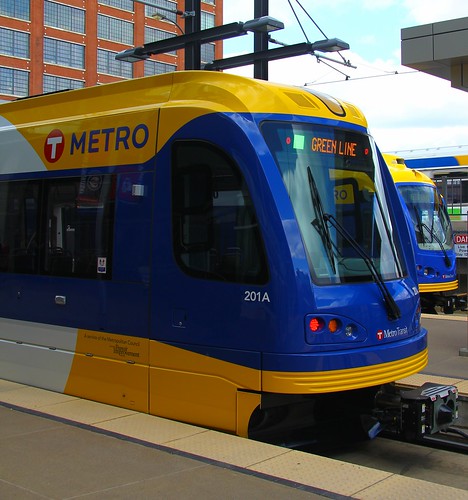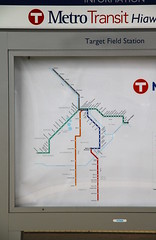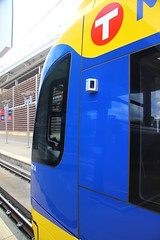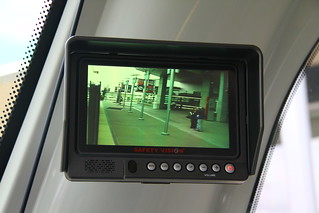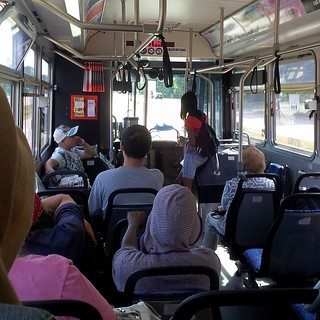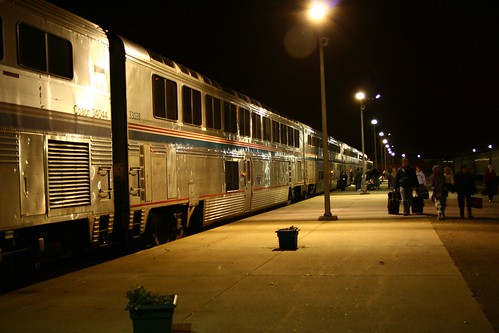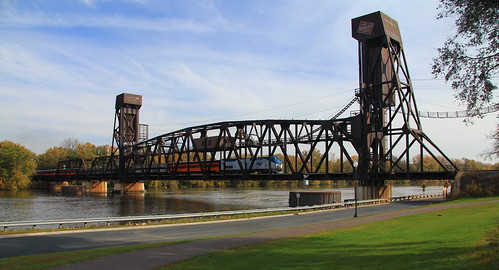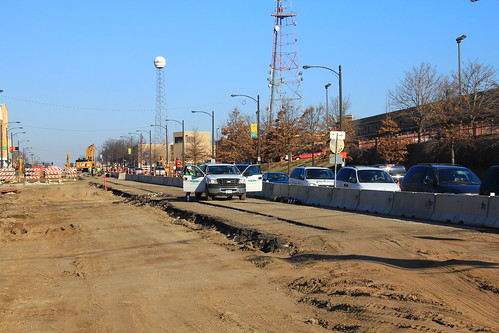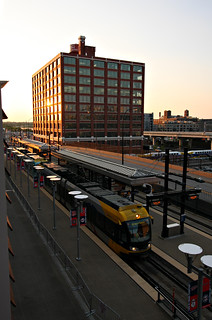
An aerial view of the Saint Paul Union Depot under construction in 1923.
After laying dormant for 41 years, the concourse and waiting room of the Saint Paul Union Depot will reopen to the public tomorrow, Saturday, December 8th. The reopening comes after a two-year, $243 million rehabilitation of the massive building and the 33-acre site it occupies, which included $148 million in construction and renovation plus $95 million for property acquisition, environmental remediation, and other work.
The Union Depot building itself is divided into three pieces: the headhouse, which sits between 4th Street and Kellogg Boulevard, the concourse, which crosses over Kellogg, and the waiting room, which extends farther south toward the Mississippi River. (The waiting room is missing from the aerial shot above, but the headhouse and concourse are visible.) The concourse and waiting room connected passengers to a massive train deck below, which raised the tracks and platforms about one story above ground level (a good way to keep tracks dry considering the Mississippi's frequent floods).
While the headhouse has largely remained open to the public ever since the depot first opened, the rear of the building was closed off in the 1970s. When Amtrak was formed in 1971, railroad operations in the Twin Cities were consolidated into the Great Northern Depot in Minneapolis, though that was demolished in 1978 after Amtrak moved operations to the current Midway station in an industrial area on the west end of Saint Paul. Tracks remained in place behind the Union Depot for several years, but were ripped out in the late 1970s when the U.S. Postal Service acquired the concourse, waiting room, and train deck below.
The USPS built skyways to a new structure on the train deck which was used as a semi-trailer truck loading dock. In order for trucks to access the loading dock, a ramp was sliced right through the train deck at Broadway Street, making it impossible to restore train tracks until the gap was filled. Much of the deck area was also converted into parking lots. With only minimal maintenance, the building and deck deteriorated over time, with peeling paint inside and rusting metal and crumbling concrete outdoors. It took on the aura of an abandoned industrial zone, seemingly too expensive to tear down, so it just became covered in asphalt and forgotten about.
The building did receive some attention over the years, particularly the headhouse which had gone through some cleanup and remodeling. 39 condominium units were added in the early 2000s to the upper floor circling around the west, south, and east sides. However, the true extent of the accumulated grime wasn't clear until the headhouse was cleaned up in 2011—Interior columns that had seemed to have a glossy gray color turned out to be a matte pink once the layered soot and grease was removed.
A concrete pedestal that had once displayed the William Crooks locomotive was removed in the renovation. It had been disguised as the Christos restaurant seating area for many years. While some railfans lamented the fact that the first steam engine to operate in Minnesota won't return to its old display location (it's now up in Duluth), the removal of the concrete pad made the Great Hall area a much more flexible space.
While the Great Hall reopened to the public at the end of 2011, renovations continued elsewhere in the building, and new structures were also added. Amtrak is not yet able to move from Midway station to the Union Depot because it has taken a long time to schedule the necessary track work to connect the new rail platform to Union Pacific and Canadian Pacific tracks that pass nearby, but Metro Transit bus service will begin at the depot tomorrow, followed in a month or so by Jefferson Lines.
The huge train deck has been slightly reduced in size to make room for wider sidewalks along Kellogg Boulevard and Sibley Street, and a bike path has been built to ride along the northern edge of the deck area (whether it connects to anything yet is unclear—the U.S. 52/Lafayette Freeway Bridge construction zone to the east may prevent it from going anywhere for a while).
At its peak around the time it opened, the Union Depot saw hundreds of trains each day. Many of these were local commuter services, a role that has been supplanted by buses today. A portion of the train deck has been dedicated to use by local, commuter, and intercity buses, while the platform Amtrak intends to use is at the southern end, closest to the Mississippi River. The ramp that the USPS sliced into the train deck has been rebuilt with a roughly right-angle turn to take buses up to this new transit center, making room for a few tracks to be restored.
In terms of tracks and platforms, the historic station was on par with the current capacity of Penn Station in New York City (which handles 15 times as many passengers daily as the Union Depot did at its peak), so it was oversized from the beginning. Unfortunately, construction of the depot wrapped up right as passenger train travel was peaking in the United States. There had been even grander visions, and at one point prior to completion, there was even talk of diverting the Mississippi to make way for additional tracks and platforms. At least the planners of the day didn't go that far overboard.
It would be a surprise if the depot ever again sees as many train passengers each day as it did in the 1920s, so a multi-modal approach is critical to bringing in enough traffic to keep the building active. Finding ways to use the depot as a public space with community events will also be essential, and hopefully some retail businesses will also be able to carve out their own spaces and find success as the structure revives. The surrounding Lowertown neighborhood has turned into one of the densest neighborhoods in the Twin Cities. While it will take a few months longer for actual trains to arrive, and years more before faster and more frequent service arrives, hopefully the return of a long-lost space will help the area continue on its upward trajectory.



